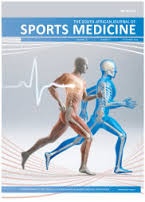Headers and concussions in elite female and male football: a pilot study
DOI:
https://doi.org/10.17159/2078-516X/2023/v35i1a15236Abstract
Background: Heading is a risk factor for neurogenerative disease in football. However, the exposure to heading in elite football training is understudied.
Objectives: The primary purpose of this study was to determine the exposure to headers in elite men’s and women’s football and to describe the effects of the headers on ocular markers.
Methods: Exposure to headers was observed over three days of women’s and men’s football. The number of headers at each session was determined through video analysis, and the G-force was determined via an impact tracker. Ocular markers were assessed at the start and end of the three days, and the results were compared to determine if there were any changes. Self-reported exposure to heading was recorded after each session and compared to the number of headers observed through video analysis, to assess the validity of players’ self-reporting.
Results: Female players made an average of 11 headers per player per session. Ninety percent of the headers were below 10G, and none were above 80G. Male players made an average of three headers per player per session, with 74% of the headers recording a G-force above 10G and 3% above 80G. No meaningful changes were observed post-session in the ocular markers, and no concussions were observed. Neither cohort was able to accurately self-report exposure to headers.
Conclusion: Longitudinal studies should be designed and conducted across different levels of play in both women and men’s football as a prerequisite to develop evidence-based measures to prevent or mitigate the potential risks associated with headers and concussions in elite football.
Downloads
Downloads
Published
Issue
Section
License
Copyright (c) 2023 South African Journal of Sports Medicine

This work is licensed under a Creative Commons Attribution 4.0 International License.
The South African Journal of Sports Medicine reserves copyright of the material published. The work is licensed under a Creative Commons Attribution 4.0 (CC BY 4.0) International License. Material submitted for publication in the South African Journal of Sports Medicine is accepted provided it has not been published elsewhere. The South African Journal of Sports Medicine does not hold itself responsible for statements made by the authors.
How to Cite
- Abstract 1065
- PDF 606
- PDF (Supplementary) 175






.png)